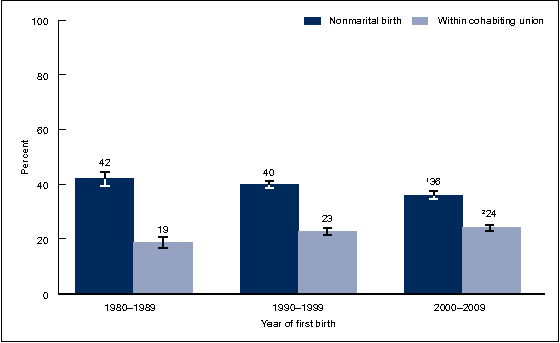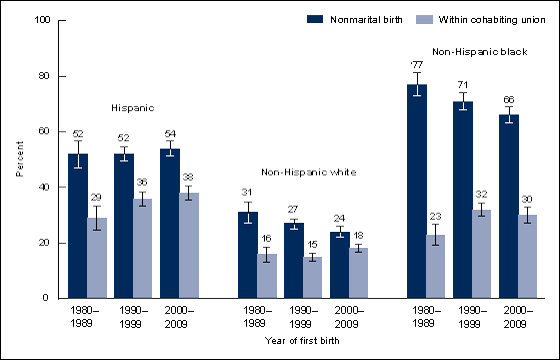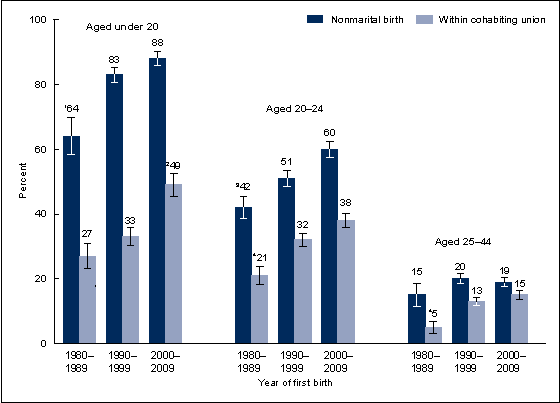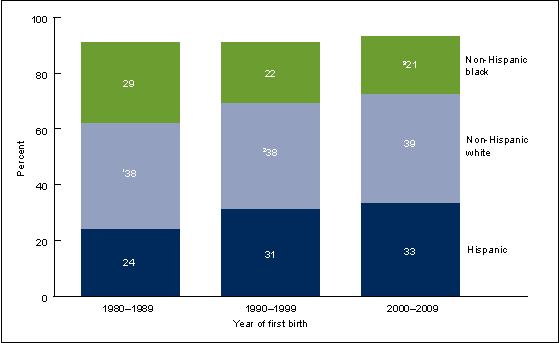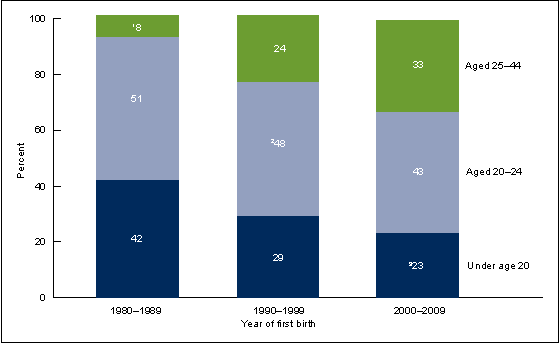Three Decades of Nonmarital First Births Among Fathers Aged 15–44 in the United States
NCHS Data Brief No. 204, June 2015
On This Page
- Key findings
- What percentage of fathers had a nonmarital first birth, and what percentage were within a cohabiting union?
- Are there differences by race and ethnicity in the percentage of fathers whose first births were nonmarital?
- Are there differences by age in the percentage of fathers whose first births were nonmarital?
- Has the Hispanic origin and race distribution of fathers having a nonmarital first birth changed over the past 3 decades?
- Has the age distribution of fathers having a nonmarital first birth changed over the past 3 decades?
- Summary
- Definitions
- Data source and methods
- About the author
- References
- Suggested citation
PDF Version (331 KB)
Gladys M. Martinez, Ph.D.
Key findings
Data from the National Survey of Family Growth
- The percentage of fathers aged 15–44 whose first births were nonmarital was lower in the 2000s (36%) than in the previous 2 decades.
- Fathers with first births in the 2000s were more likely to be in a nonmarital cohabiting union (24%) than those in the 1980s (19%).
- The percentage of fathers with a nonmarital first birth over the past 3 decades has remained similar for Hispanic and non-Hispanic white men, but has declined for non-Hispanic black men (1980s, 77%; 2000s, 66%).
- Fathers with nonmarital first births in the 2000s were less likely to be non-Hispanic black men (21%) than Hispanic (33%) or non-Hispanic white (39%) men.
- Fathers with nonmarital first births in the 2000s were more likely to be older at the time of the birth (33%) than those in the previous 2 decades.
Nonmarital childbearing in the United States increased from the 1940s to the 1990s, peaked in 2007–2008, and declined in 2013 (1–3). In 2013, the nonmarital birth rate was 44.8 births per 1,000 unmarried women aged 15–44. Using data from the National Survey of Family Growth (NSFG), this study examines nonmarital first births reported by fathers aged 15–44. This report presents trends in nonmarital first births by father’s age at birth and Hispanic origin and race. Given increases in births occurring in cohabiting unions (2,4,5), first births within cohabitation are also examined.
Keywords: nonmarital birth, cohabitation, National Survey of Family Growth
What percentage of fathers had a nonmarital first birth, and what percentage were within a cohabiting union?
- Among men with first births fathered in the 1980s, 42% were nonmarital (Figure 1). By the 2000s, the percentage that was nonmarital declined to 36%.
- About one-quarter of fathers with first births in the 2000s had them within a cohabiting union.
- Fathers with first births in the 2000s were more likely to have them within a cohabiting union (24%) than those in the 1980s (19%).
Figure 1. Percentage of fathers whose first birth was nonmarital, and percentage whose first birth was within a cohabiting union
1Percentage of fathers with nonmarital first births was significantly lower in 2000–2009 than in 1980–1989 and 1990–1999 (p < 0.05).
2Percentage of fathers with first births within a cohabiting union was significantly higher in 2000–2009 than in 1980–1989 (p < 0.05).
NOTES: The denominator for the percentages is the number of fathers with first births in that decade. Access data table for Figure 1 [PDF-137KB].
SOURCE: CDC/NCHS, National Survey of Family Growth, 2002, 2006–2010, and 2011–2013.
Are there differences by race and ethnicity in the percentage of fathers whose first births were nonmarital?
- Over the past 3 decades, about one-half of Hispanic fathers had first births that were nonmarital (52%–54%), and about one-third were within a cohabiting union (29%–38%) (Figure 2).
- Among non-Hispanic white fathers, about one-quarter had a nonmarital first birth. This percentage has declined from 31% to 24% over the past 3 decades, but the differences are not statistically significant. In addition, about one of every five first births among non-Hispanic white fathers in the 2000s occurred within a cohabiting union. This percentage has remained similar in the past 3 decades (16%–18%).
- The percentage of non-Hispanic black fathers with nonmarital first births declined from 77% in the 1980s to 66% in the 2000s; the percentage of non-Hispanic black fathers with first births that occurred within cohabiting unions was similar over the past 3 decades (23%–32%).
Figure 2. Percentage of fathers whose first birth was nonmarital, and percentage whose first birth was within a cohabiting union, by Hispanic origin and race
1Percentage of non-Hispanic black fathers with nonmarital first births was significantly lower in 2000–2009 than in 1980–1989 (p < 0.05).
NOTES: The denominator for the percentages is the number of fathers with first births in that decade for each racial and ethnic group. Access data table for Figure 2 [PDF-137KB].
SOURCE: CDC/NCHS, National Survey of Family Growth, 2002, 2006–2010, and 2011–2013.
Are there differences by age in the percentage of fathers whose first births were nonmarital?
- Teen fathers (under age 20) in the 1990s and 2000s were more likely to have a nonmarital first birth than those in the 1980s (Figure 3). About one-half of teen fathers in the 2000s had their first birth within a cohabiting union (49%), an increase from the 1980s (27%) and 1990s (33%).
- Fathers aged 20–24 were more likely to have a nonmarital first birth in the 2000s (60%) than those in the 1990s (51%) or 1980s (42%). In the 1980s, a smaller percentage of these fathers had a first birth within a cohabiting union (21%) compared with the 1990s (32%) and the 2000s (38%).
- Among fathers who had their first births at ages 25–44, the percentage who had nonmarital first births did not differ significantly in the past 3 decades. But the percentage of these fathers who had a first birth within a cohabiting union increased in the 1990s (13%) and 2000s (15%) compared with those in the 1980s (5%).
Figure 3. Percentage of fathers whose first birth was nonmarital, and percentage whose first birth was within a cohabiting union, by age at first birth
1Percentage of fathers under age 20 with nonmarital first births was significantly lower in 1980–1989 than in 1990–1999 and 2000–2009 (p < 0.05).
2Percentage of fathers under age 20 with first births within a cohabiting union was significantly higher in 2000–2009 than in 1980–1989 and 1990–1999(p < 0.05).
3Linear increase in the percentage of fathers aged 20–24 with nonmarital first births from 1980–1989 to 2000–2009 was statistically significant (p < 0.05).
4Percentage of fathers aged 20-24 and 25-44 with first births within a cohabiting union was significantly lower in 1980–1989 than in 1990–1999 and 2000–2009 (p < 0.05).
NOTES: The denominator for the percentages is the number of fathers with first births in that decade for each age group. Access data table for Figure 3 [PDF-137KB].
SOURCE: CDC/NCHS, National Survey of Family Growth, 2002, 2006–2010, and 2011–2013.
Has the Hispanic origin and race distribution of fathers having a nonmarital first birth changed over the past 3 decades?
- About 33% of nonmarital first births were fathered by Hispanic men in the 2000s, an increase from 24% in the 1980s (Figure 4). Between 38% and 39% of nonmarital first births were fathered by non-Hispanic white men in each decade.
- The percentage of nonmarital births fathered by non-Hispanic black men declined over time (from 29% to 21%), while the percentage fathered by Hispanic men increased (from 24% to 33%).
- In the 1980s and 1990s, the percentage of nonmarital first births was highest for births fathered by non-Hispanic white men.
Figure 4. Percent distribution by race and ethnicity among fathers with nonmarital first births
1Percentage of nonmarital first births to non-Hispanic white fathers in 1980–1989 was significantly higher than for Hispanic fathers (p < 0.05).
2Percentage of nonmarital first births to non-Hispanic white fathers in 1990–1999 was significantly higher than for non-Hispanic black and Hispanic fathers (p < 0.05).
3Percentage of nonmarital first births to non-Hispanic black fathers in 2000–2009 was significantly lower than for non-Hispanic white and Hispanic fathers (p < 0.05). This percentage has declined since 1980–1989.
NOTE: Access data table for Figure 4 [PDF-137KB].
SOURCE: CDC/NCHS, National Survey of Family Growth, 2002, 2006–2010, and 2011–2013.
Has the age distribution of fathers having a nonmarital first birth changed over the past 3 decades?
- About 4 of 10 fathers with nonmarital first births in the 1980s (42%) were younger than age 20 (Figure 5). The percentage of nonmarital first births to teen fathers declined in the 1990s (29%) and the 2000s (23%).
- Mirroring a delay in childbearing overall (4), the percentage of nonmarital first births fathered by men aged 25–44 increased over time. In the 1980s, 8% of nonmarital first births were fathered by men aged 25–44. This percentage increased in the 1990s (24%) and again in the 2000s (33%).
- The percentage of nonmarital first births fathered by men in their early 20s (ages 20–24) was lower in the 2000s (43%) than in the 1980s (51%).
Figure 5. Percent distribution of father’s age at nonmarital first birth
1Percentage of nonmarital first births to fathers aged 25–44 in 1980–1989 was significantly lower than those for age groups under 20 and 20–24 (p < 0.05).
2Percentage of nonmarital first births to fathers aged 20–24 in 1990–1999 was significantly higher than those for age groups under 20 and 25–44 (p < 0.05).
3Percentage of nonmarital first births to fathers under age 20 in 2000–2009 was significantly lower than those for age groups 25–44 and 20–24 (p < 0.05). The percentage of nonmarital first births to teen fathers has declined significantly over time.
NOTE: Access data table for Figure 5 [PDF-137KB].
SOURCE: CDC/NCHS, National Survey of Family Growth, 2002, 2006–2010, and 2011–2013.
Summary
This report highlights data on nonmarital first births fathered by men aged 15–44 at the time of interview. Using pooled data from the 2002, 2006–2010, and 2011–2013 NSFG, results for 3 decades were estimated based on retrospective information on the date of the father’s first birth. Results from this study indicate that in the 2000s, the percentage of fathers with nonmarital first births declined. However, the percentage of fathers whose nonmarital first births occurred within a cohabiting union increased. This pattern differs from that for the mother. Data for women showed that the share of all births that occured to unmarried women has doubled between 1988 and 2009–2013, and that the increase was driven by an increase in the share of births to cohabiting women (4).
The percentage of fathers with nonmarital first births decreased over time for non-Hispanic black fathers but remained unchanged for non-Hispanic white and Hispanic fathers. The percentage of first births occurring in cohabiting unions remained the same for non-Hispanic white, Hispanic, and non-Hispanic black fathers in the past 3 decades. However, the percentage of first births occurring within a cohabiting union was greater for women than for men, regardless of Hispanic origin and race (5). The proportion of teen births that occurred within a nonmarital union increased in the past 2 decades. Nonetheless, in contrast with the decline in the teen birth rate among women (3), the percentage of teen fathers with nonmarital first births increased.
Because information on fathers’ births collected from women often contains missing data, and women of reproductive ages (15–44) do not necessarily have children with men of their age, it is important to look at trends in nonmarital births from the perspective of the men fathering these births. In addition, data on marital and cohabiting status at the first birth provide information on the transition to parenthood, which may influence subsequent fertility-related behavior (6).
Definitions
Nonmarital birth: A birth fathered by a man before he ever married, regardless of whether he later marries.
Cohabiting union: Men who report in the survey that they are unmarried but “having sexual relationships while sharing the same usual address” with the mother of their child.
Births fathered: Refers to the man being the biological father of the child.
Percentage of nonmarital births: The numerator of this percentage is the number of men who had a nonmarital first birth in a specific decade; the denominator is the number of men aged 15–44 who ever had a child.
Percentage of births within cohabiting union: The numerator of this percentage is the number of men who had a nonmarital first birth within a cohabiting union in a specific decade; the denominator is the number of men aged 15–44 who ever had a child.
Father’s age: For this analysis, fathers were aged 15–44 at the time of the 2002, 2006–2010, or 2011–2013 interview. In Figures 3 and 5, the father’s age is based on his age at the time he fathered his first birth.
Hispanic origin and race: The recode variable HISPRACE2 is used for Hispanic origin and race. This recode, based on 1997 Office of Management and Budget (OMB) guidelines (7), allows respondents to report more than one race or ethnic origin. In this report, the categories Hispanic, non-Hispanic white single race, and non-Hispanic black single race are presented. For ease of writing, non-Hispanic white single race is referred to as non-Hispanic white, and non-Hispanic black single race is referred to as non-Hispanic black.
Data source and methods
Pooled data from the 2002, 2006–2010, and 2011–2013 NSFG were used for these analyses. NSFG is a nationally representative survey of the U.S. household population, with face-to-face interviews conducted with women and men aged 15–44 (8). The pooled data consisted of 20,146 men aged 15–44 (4,928 interviewed in 2002, 10,403 interviewed in 2006–2010, and 4,815 interviewed in 2011–2013). All estimates in this report were weighted to reflect the male household population aged 15–44 of the United States in 2002 and at the midpoints of 2006–2010 interviews (July 2008) and 2011–2013 interviews (July 2012). More information on NSFG is available. Statistics for this report, including sampling errors, were produced using the survey analysis procedures in SAS software version 9.3. Percentages were compared using two-tailed t tests at the 5% level. The difference between any two estimates is mentioned in the text only if it is statistically significant. In addition, a weighted least squares regression method was used to test the significance of trends that involved more than two time points. Terms such as “similar” or “no significant differences” indicate that the estimates being compared are not significantly different. This report presents descriptive statistics and bivariate associations of nonmarital first births and father’s cohabiting status with Hispanic origin and race, which may be explained by other factors not controlled in the analysis.
About the author
Gladys M. Martinez is with CDC’s National Center for Health Statistics, Division of Vital Statistics, Reproductive Statistics Branch.
References
- Ventura SJ, Bachrach CA. Nonmarital childbearing in the United States, 1940–99. National vital statistics reports; vol 48 no 16. Hyattsville, MD: National Center for Health Statistics. 2000.
- Curtin SC, Ventura SJ, Martinez GM. Recent declines in nonmarital childbearing in the United States. NCHS data brief, no 162. Hyattsville, MD: National Center for Health Statistics. 2014.
- Martin JA, Hamilton BE, Osterman MJK, et al. Births: Final data for 2013. National vital statistics reports; vol 64 no 1. Hyattsville, MD: National Center for Health Statistics. 2015.
- Manning WD, Brown SL, Stykes B. Trends in births to single and cohabiting mothers, 1980–2013. National Center for Family & Marriage Research, FP–15–03. Bowling Green, Ohio: Bowling Green State University. 2015.
- Martinez G, Daniels K, Chandra A. Fertility of men and women aged 15–44 years in the United States: National Survey of Family Growth, 2006–2010. National health statistics reports; no 51. Hyattsville, MD: National Center for Health Statistics. 2012.
- Cherlin AJ. New developments in the study of nonmarital childbearing. In: Wu LL, Wolfe B, editors. Out of wedlock: Causes and consequences of nonmarital fertility. New York, NY: Russell Sage Foundation; p 390–402. 2001.
- OMB. Revisions to the standards for the classification of federal data on race and ethnicity. Fed Regist 62(210):58782–90. 1997.
-
Lepkowski JM, Mosher WD, Groves RM, et al. Responsive design, weighting, and variance estimation in the 2006–2010 National Survey of Family Growth. National Center for Health Statistics. Vital Health Stat 2(158). 2013.
Suggested citation
Martinez GM. Three decades of nonmarital first births among fathers aged 15–44 in the United States. NCHS data brief, no 204. Hyattsville, MD: National Center for Health Statistics. 2015.
Copyright information
All material appearing in this report is in the public domain and may be reproduced or copied without permission; citation as to source, however, is appreciated.
National Center for Health Statistics
Charles J. Rothwell, M.S., M.B.A., Director
Nathaniel Schenker, Ph.D., Deputy Director
Jennifer H. Madans, Ph.D., Associate Director for Science
Division of Vital Statistics
Delton Atkinson, M.P.H., M.P.H., P.M.P., Director
- Page last reviewed: November 6, 2015
- Page last updated: June 4, 2015
- Content source:


 ShareCompartir
ShareCompartir
